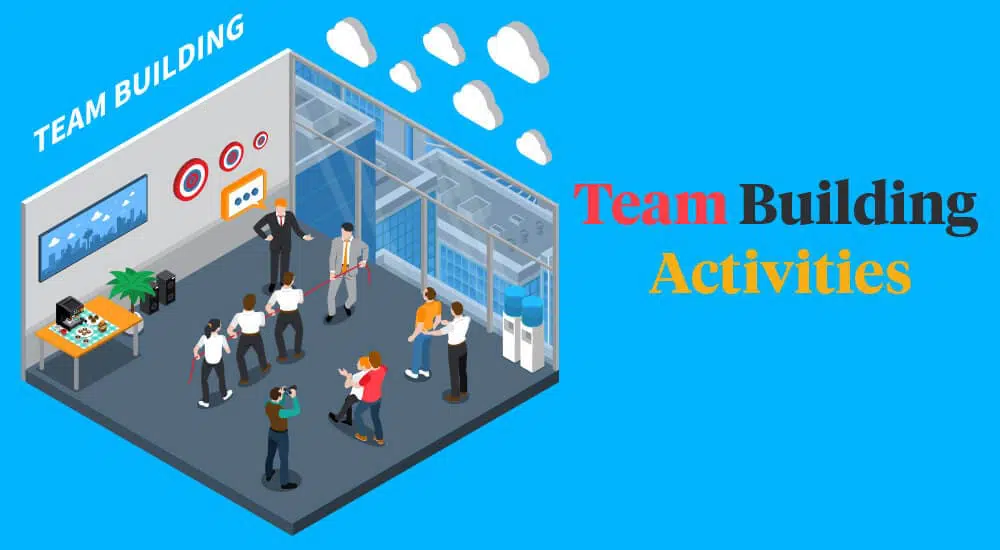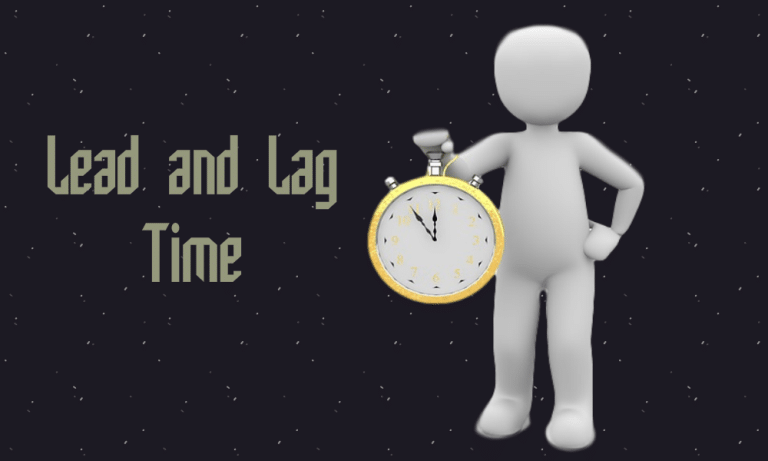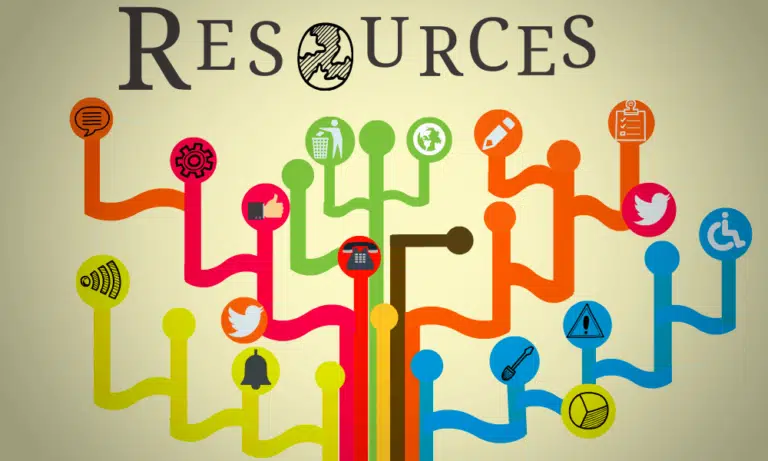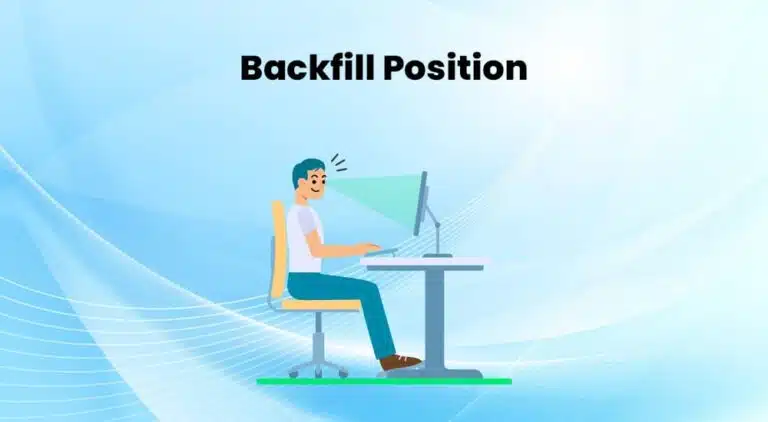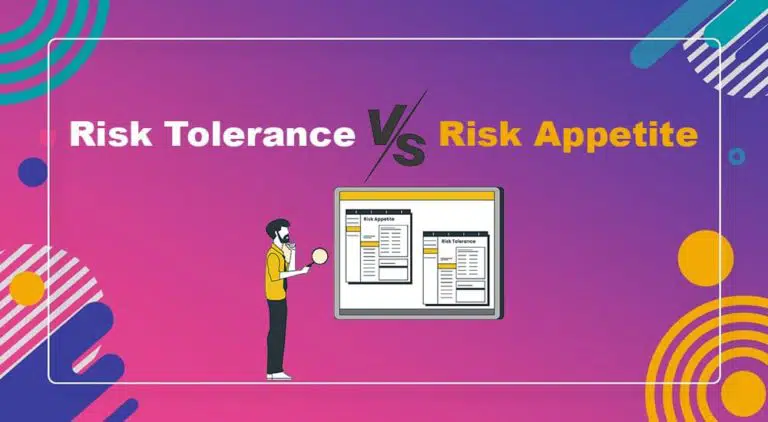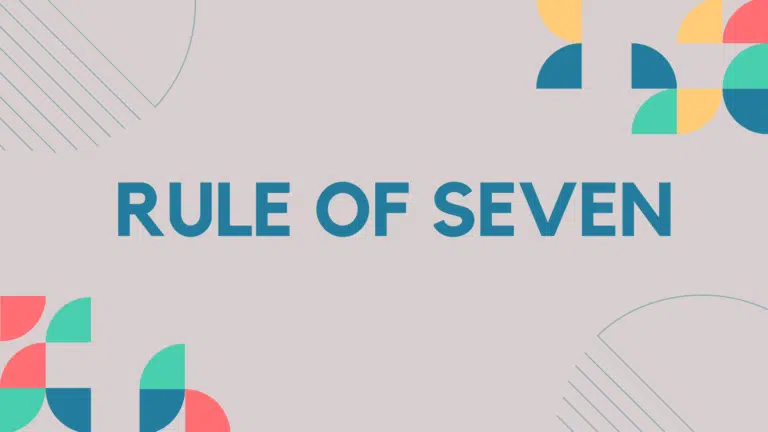Team building activities are essential for any team because they are not a random group of people. Instead, these are people who group to achieve a common goal.
Teams, not individuals, deliver projects. Therefore, they must work collaboratively instead of independently to achieve the goal.
Furthermore, team building activities bond team members so they can connect, collaborate, and work more efficiently.
Team Building Activities
Team building activities help build teams and motivate members to work as a cohesive group.
In the 1990s, a group of researchers studied several successful American companies. They found that “The ability to organize employees in innovative and flexible ways and the enthusiasm with which so many American companies have developed self-managing teams is why U.S industry is looking so competitive.”
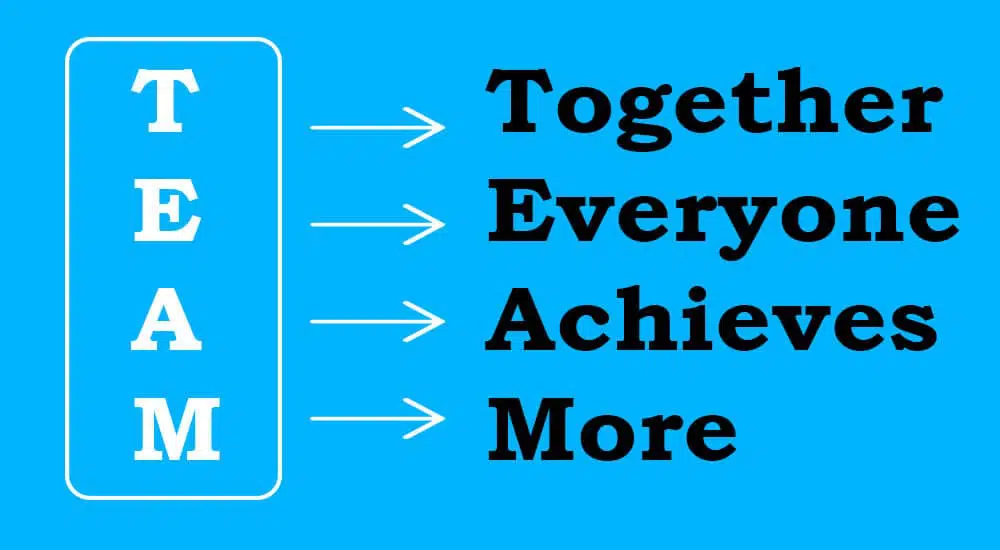
Another study by Gallup shows that close work friendships boost employee satisfaction by 50%, while people with a self-described best friend at work were seven times more engaged.
Business environments are VUCA (Volatile, Uncertain, Complex, and Ambiguous), and organizations need to optimize human resources.
Team building helps form, grow, and improve team members’ knowledge, skills, and attitudes.
Knowledge, skills, and attitude boost the team’s competency, and the project manager encourages members to improve these elements.
Team building takes individuals with diverse backgrounds and skills and transforms them into an effective workgroup.
The aim is to channel the energies of individual members into achieving the team objective.
How to Organize Team Building Activities
You require the following steps for a successful team building activity:
- Select an Activity: Keep the business reasons and benefits in mind to ensure the activity provides value to the team.
- Prepare for Activity: Read the details, get all materials, prepare the roles, and set up the room/stage.
- Explain the Activity: Clear goals and explicit rules lead to better engagement. Ensure the team understands the activity and guidelines. Organizers should enthusiastically welcome the team before the briefing.
- Conduct the Activity: This is when the game starts. Members participate in the activity with minimal interference from the organizer.
- Debrief the Activity: The organizer discusses findings and observations during the activity. Then, they can prepare questions in advance for discussion.
- Reinforce the Learning: The goal of the activity is to improve team dynamics. Motivate members to apply it in the workplace.
Example of Team Building Activities
Team building activities can help improve several skills, such as teamwork, communication, coping, creativity, cooperation, support, problem-solving, etc.
Each theme has different activities, and we will discuss these activities under the theme.
Let’s start with the first theme, i.e., teamwork.
(a) Teamwork Activities
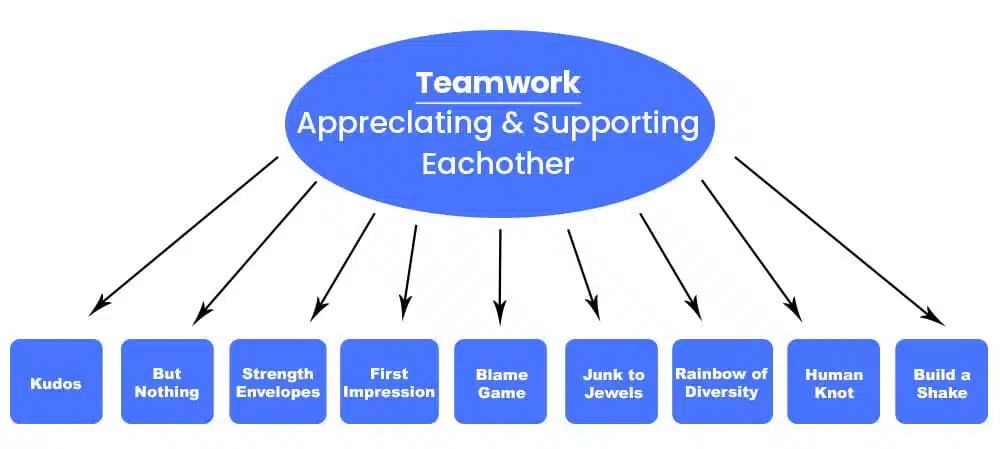
This theme has nine activities, but we will discuss five team building activities.
#1. Kudos
In this activity, participants appreciate one another for their differences. This helps bolster the team’s energy and promotes bonding and confidence among members.
This activity requires a box of candy called the kudos box.
Steps for conducting kudos:
- Show a kudos box to the team.
- Explain to the team that the candy bars are a recognition reward for any action, accomplishment, or trait.
- Anyone can give more than one candy bar for any reason.
- You must voluntarily give Kudos.
- The organizer starts the game. They reward a participant for something and explain the reason.
- Everyone else follows suit with a round of applause at every recognition.
- The game continues until the energy level drops or the candy bars are gone.
After the activity ends, the organizer calls the team for a debriefing session with the following questions:
- How difficult was it to give each other recognition? Why or why not?
- How did you feel after each recognition?
- What do you think would happen if we extend this attitude of recognition to external partners like suppliers, vendors, support staff, regulatory bodies, or clients?
The kudos box teaches appreciation and recognition of members.
#2. But Nothing (Ideas)
Here, participants give feedback using the phrase yes, but… Then, instead, they use yes… or yes and…
This activity shows how “but” can shut down communication.
Steps for conducting but nothing (ideas)
- Have the participants pair up.
- Each pair has to plan a dream vacation.
- One partner starts by making suggestions to the other.
For example:
Person A: Let’s go to the beach.
Person B: Yes, but…
Keep this up for one minute, and then stop.
In contrast:
Have the conversation change but… to yes, and…
Keep it up for one minute, and then stop.
Debrief session:
- Did you have more fun playing the game in yes, but, or yes, and?
- In real life, how does a yes, but affect thought or flow compared with a yes, and?
Teamwork is encouraged with a yes, and. The former (yes, and) builds on while the latter (yes, but) tears it down.
#3. Strength Envelopes
The team will be able to uncover and share individual strengths, which will help boost performance and structure roles, thanks to this exercise. It is ideal for a team with 5 to 9 team members.
Materials
- Envelopes
- Writing sheet and pens
- Timer
- Whistle
Steps for conducting Strength Envelopes:
- Organize participants into teams and ask each team to sit around a table.
- Explain the activity’s objective, which is to reveal individual strength as perceived by colleagues.
- Hand each participant the envelope, writing sheet, and pen.
- Ask participants to write their names on the envelope and pass it to the person on the left.
- Set the timer for three minutes and ask each participant to write the strength of the colleagues whose envelope they possess in the sheet.
- After three minutes, team members will fold the sheet, inserts it in the envelope, and passes to the person on the left.
- Repeat the cycle in the same fashion until each envelope has gone around the participants and returned to the name bearer.
- Ask participants to open their envelope containing several comments by colleagues on the participant’s strengths.
Retire to a more convenient location to evaluate the strengths that were listed. When done in good faith, it encourages cooperation and collaboration among team members, demonstrating that the outcome is impacted by even the team’s weakest link.
#4. Build a Shake
This activity helps participants learn tactics from others; it brings the group close through interaction.
Material
- None
Steps for conducting handshake activity:
- Pair participants.
- Each participant has to find a partner. Both partners will make a two-step handshake, e.g., pound it, squeeze it, high-five, tick, etc.
- Both partners practice this until they know the steps and can teach them to someone else.
- Each then finds a new partner and teaches the same.
- Both partners show each other previously learned handshake style.
- This continues until it has gone around the team, with each successive step leading to more learning.
- In the end, each participant demonstrates his best handshake after all.
Debrief Session:
- How did you feel learning something from a peer?
- How important is diversity in team performance?
- Are we better at interacting than keeping to what we know?
#5. Human Knot
This game teaches people to work together. It breaks the ice in a new team.
Materials
- No material but just moderate space.
- Total time: 20 to 30 minutes
Steps for conducting Human Knot:
- Get the group to form a circle.
- Ask the group to raise their right hand and then move across to grab the right hand of another. (They cannot grab the right hand of someone by their side).
- Then repeat the same with the left hand, ensuring they grab a different person’s hand.
- The facilitator will check that participants have grabbed one another’s hand, forming a chain and none grabbed somebody by the side but across.
- They must try to untangle the knot but not break the chain. This will take careful and thoughtful steps collaboratively. (Ask them to be gentle to avoid injury).
The facilitator monitors and ensures that only thoughtful steps are taken to untangle. If he suspects the likelihood of injury, he may stop the activity.
If the chain becomes broken while the team attempts to untangle it, they begin the process again.
Debriefing Session: The facilitator will ask the group to discuss what they have learned, such as how to work together effectively, how to manage their time effectively, and how to plan strategically.
(b) Communication Activities
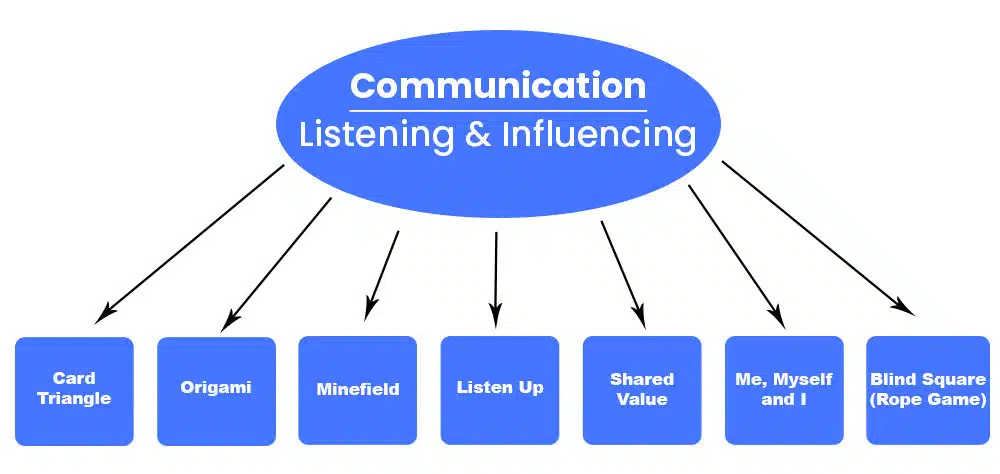
These activities help improve communication. Here, we will discuss four team building activities.
#6. Card Triangles
This is a negotiation activity where teams trade pieces of playing cards in exchange for complete cards. It helps to see other perspectives before persuading or influencing.
Steps for conducting card triangles:
- Prepare the materials by cutting the card into four parts, and participants must complete the card again. Then randomly divide these pieces into three or four envelopes according to the number of teams.
- Divide the participants into teams of three or four.
- Give each team an envelope containing card pieces.
- Give them three minutes to examine, sort their pieces, and plan their bartering strategy.
- Allow eight minutes of bartering where team members negotiate or influence to complete cards.
- At the end of the time, the winning team has the highest number of complete cards.
Debrief with the following questions:
- How willing were others to trade with you?
- What were negotiation tactics most effective for you?
- What things do we negotiate? (time, resources, etc.)
Card triangles show us we depend on colleagues and need an influenceable relationship with effective communication.
#7. Origami
This activity shows the power of clear communication. It derives its name from the Japanese art of folding paper.
Steps for conducting origami:
- Give each participant a sheet of paper.
- Have them close their eyes.
- Let them know they only must follow instructions as heard; no clarification is allowed.
- Instruct members to fold the sheet of paper in half, then fold again in half, and lastly, fold again in half. Then rip off the upper corner
Debrief with the following questions:
- Did everyone end up with the same result? Why or why not?
- How could the result have been different if our eyes were open?
- What if I asked for clarification? Would the results have been different?
- What does this imply about our jobs?
Origami helps participants see how they interpret instructions differently, and that clear communication is vital.
#8. Minefield
This is an activity where participants test listening and trust skills. Team members need to learn to trust instructions or ideas from teammates. It helps participants understand and work with precise instructions and communication.
Materials
- Blindfolds
- Balls to serve as treasure
- Trashcan to serve as obstacle
Steps for conducting Minefield:
- Pair participants and let them discuss hindrances to team spirit.
- The facilitator throws an object into the playing space or the minefield.
- A participant is blindfolded while the partner directs him to the exact location of the treasure.
- Once the blindfolded partner hits an obstacle, he is made to step backward as a penalty.
- He continues until he successfully picks up the treasure. Time is recorded, and the next group does the same until all teams complete the exercise.
Debrief Session: The facilitator discusses the following questions among participants
- How did you feel being blindfolded to pick the treasure?
- How did you feel having to lead a ‘blind’ partner correctly?
- How can clear communication help in day-to-day work life?
#9. Blind Square-Rope Game
This activity engages a team and encourages them to plan and execute together, improving communication.
Materials
- Rope (about 20 meters)
- Blindfolds
Steps for conducting Blind Square- Rope Game
- Before the exercise begins facilitator forms the rope into a circle and provides blindfolds for everyone.
- The facilitator will ask the team to form the rope into a square while blindfolded.
- The team will have 15 minutes to plan before blindfolding.
- After 15 minutes, team members are blindfolded, and the rope is placed in their hands.
- Participants are given 10 minutes to form the square.
- Once the time is up, or the team has formed a square, they gently lay the rope on the floor for assessment.
Debrief Session: Ask participants about the importance of the following:
- Attention to detail, effective planning, communication, and collaboration.
(c) Coping Activities
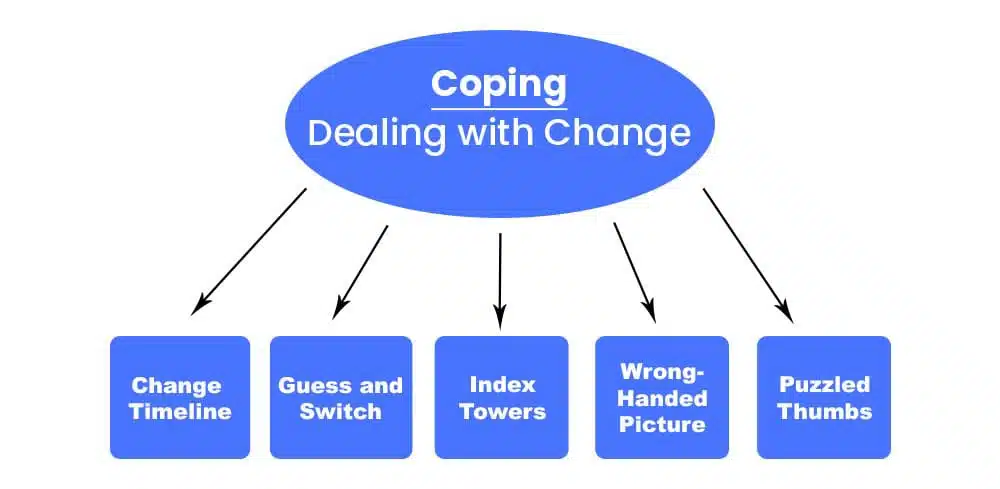
These activities help improve coping skills.
We will discuss the change timeline and index towers activities.
#10. Change Timeline
This activity reminds participants of major changes they have handled before. In addition, it helps participants know one another better and encourages them to discover each other’s similar or dissimilar experiences.
Steps for conducting change timeline:
- Give a pen and paper to each participant.
- Have them each recall five major life events.
- They will draw timelines with associated changes marked with an X.
Have the participants then pair up and share outcomes using the following questions:
- How did you feel before, during, and after these changes?
- Was the change difficult? Why or why not?
- What was the key to your success in dealing with the change?
Debrief by examining the following questions:
- How do you feel about sharing these experiences with your partner? Some responses could be I felt empathetic or encouraged knowing that we have experiences in common.
- What did you learn from how your partner dealt with the change?
- What does this bring to our jobs?
Change is common, and everyone can deal with it.
#11. Index Towers
This is a game to test adaptability to change. Here you have a team of participants build towers using index cards.
Steps for conducting index towers:
- Divide the group into teams of three to five.
- Give them twenty-five index cards.
- Each team has to build the tallest free-standing structure possible.
- Give participants a tape ruler to measure the height.
- After taking the measurement, announce that the towers violate safety laws, and we must start over.
- Give them twenty-five new cards and have them rebuild the tower.
- Measure the structure and determine the tallest.
Debrief by examining the following questions
At the end of the activity, discuss the following:
- How did you decide to build the structure each time?
- How did you feel when we announced a rule change and started all over? (frustrated, upset, challenged, etc.)
- What new methods did you discover in the second round? (found better ways of stacking).
- How does this apply to your job?
(d) Creativity Activities
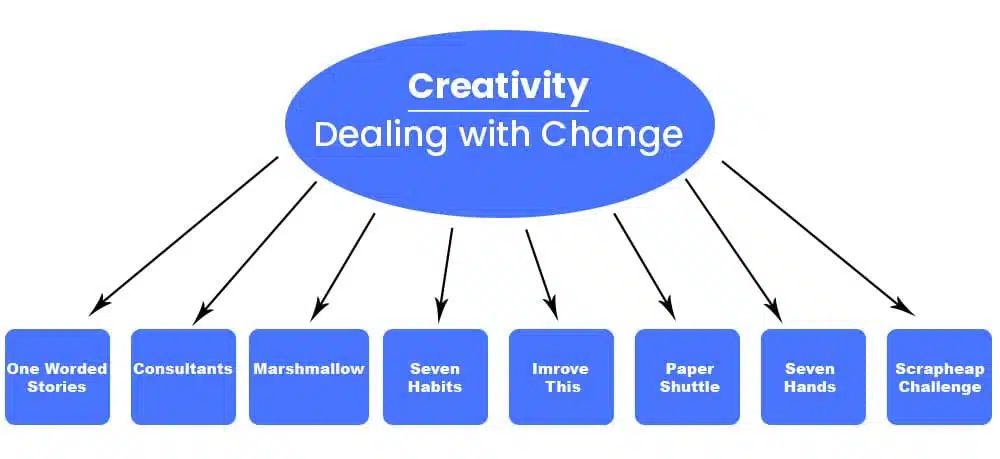
This activity helps improve creativity.
We will discuss four activities for team building.
#12. Consultants
This activity allows participants to suggest how to handle work or other related problems. It takes creativity as participants proffer solutions as they come to mind. The solution seeker can now combine or scamper the ideas as below.
S – Substitute
C – Combine
A – Adapt
M – Modify
P – Put to another use
E – Eliminate
R – Rearrange
Steps for conducting consultants:
- Give the group two minutes for each participant to write one problem or concern at the top of a paper.
- Have everyone pass their paper to the right.
- Each participant has one minute to read the problem and write a suggestion/advice.
- Pass the paper and repeat as often as time allows.
- Return the papers to the original owners.
For example:
Participant 1: I have issues replying to emails.
Response:
Participant 2: Read your email out aloud.
Participant 3: Flag all emails as unread.
Participant 4: Confide in a colleague at the end of the day.
Participant 5: Learn to acknowledge first.
Debrief with the following questions:
- How many team members had ideas that would solve their problems?
- How did you feel about suggesting solutions/advice (challenged, excited, honored)?
- Why don’t we ask each other for help more often? (not confident others could help, fear of trust/confidentiality).
- How do we bring this experience to our job?
The consultant game shows how participants solve problems by sharing ideas.
#13. One-Worded Stories
This activity sparks creativity. You must keep the story flowing. Participants must contribute one word at a time to keep the game going.
Steps for conducting one-word stories:
- Explain that the group will create a story together, one word at a time.
- The word used must be as interesting as possible, supporting the preceding word.
- Select one participant to start.
For example
Participant 1: Once
Participant 2: upon
Participant 3: a
Participant 4: time
Participant 5: my
Participant 6: uncle
Participant 7: had
Participant 1: a
Participant 2: car
Participant 3: which
- The story continues until the energy dies out.
- After the story, try another round until the group gets better. This brain exercise improves idea generation and creativity.
- Participants can take someone else’s place when they run out of ideas.
Debrief with the following questions:
- How would you compare the group’s collective story with yours (was it more creative and original)?
- How many came up with unimaginable words? (Innate capability)
- How does this apply to our jobs?
#14. Marshmallow Challenge
This activity shows the power of collaboration, creativity, and innovation among team members.
By participating in this activity, you can determine how well your team communicates and collaborates. Give them this challenge, and you will know. Keep in mind that activities aim to establish and develop teams, not evaluate and judge them. During the debrief session, the facilitator should be approachable, observe, take notes, and address any areas of weakness.
Steps for conducting Marshmallow Challenge:
- Read out the challenge, i.e., build the tallest freestanding structure with a marshmallow on top.
- Provide the kit to the team and give them a fixed duration, e.g., 20 minutes.
- The kit can consist of 20 dry spaghetti, 1-yard masking tape, 1-yard string, a ruler, scissors, and a marshmallow.
- The facilitator will need a timer and a measuring tape to measure the structure’s height.
- Read the instruction; the full marshmallow must stay on top of the final structure; teams are permitted to break the spaghetti, but no additional material will be provided.
After the duration, the activity stops, and the facilitator will measure the structure’s height. If more teams are involved, the result can be as follows:

You can award a gift to the team with the tallest structure. The award can be candy, meals, movie tickets, etc.
Debrief Session: This is the essence of the activity. Discuss the observation and areas of improvement.
You can ask questions like
- What worked well?
- How did it go?
- What were your drawbacks, and how did you handle them?
- How much planning and communicating did you engage in?
- Did you assign roles, or did everyone play naturally?
- How will you do it next time?
The facilitator should have a goal about what they want to achieve with this activity. That goal drives the debrief.
#15. Scrapheap Challenge
This activity involves creative thinking. Teams are tasked to make a product that will protect an egg inside it when released from height.
Materials
- Scrap; old newspaper, scissors, eggs, tape
- Space required: Small indoor or outdoor.
- Group size: ideal 4-8
Steps for conducting Scrapheap Challenge
- Organize the group (if large) into teams of 4-8 participants.
- Instruct the team to build a product to protect an egg when dropped from a height.
- Provide each team with an equal amount of scrap and give 10 minutes for planning the product.
- Once they’ve planned their design, allocate 30 minutes to build the product. If a team breaks the egg while building, they are disqualified automatically.
- Once the time is up, and their builds are ready for launch, each team nominates one person to present it to the facilitator.
- The facilitator now tests by dropping the product from a height.
- The facilitator inspects the product for the egg to see if it is safe.
Debrief Session: Ask participants the following questions
- How easily did you come up with a design?
- Did everyone have input into the final build?
- How did you manage your time?
- Are you happy with your design?
- Did you notice divergent views at the start? How did you handle it?
Problem Solving
Here we will discuss one activity, i.e., a virtual scavenger hunt.
#16. Virtual Scavenger Hunt
Virtual Scavenger Hunt is one of the most popular games for team building.
This is a game full of fun and excitement. It shows how fast team members can hunt for items. The person or team that comes first wins the game. Creativity and problem-solving skills are required to win.
Steps for conducting a virtual scavenger hunt:
- Compile a list of items that participants need to scavenge or hunt for. Since we have it virtual, think of common items where the participants are located. For example, holding a phone charger, hand sanitizer, face mask, a souvenir, shopping bag, or coffee mug. Ensure the challenge or items are fun to get.
- Connect participants on Zoom or any video-enabled meeting platform. Allow time for everyone to join the call.
- Divide participants into groups and have them name their team. There could be a breakout session where participants decide on the names. Then, bring everyone again to the common space and introduce the teams with their names.
- Give instructions for the game. This may include activity time and instructions, such as submitting real items, no images, or screenshots. You may assign points to a team instead of an individual. Let’s say we have five participants in a team, and three came up with the items; they could still have a full score to promote team spirit.
The emphasis is not on wins but on team engagement.
- Start the Hunt: Once you are sure everyone understands the rules and expectations of the game, have the teams return to their breakout room with the countdown timer on their screen. Ten minutes is usually enough for the hunt.
- Name the Winner: After the timer hits zero, everyone should rejoin the common room, where the organizer displays the photos of each team. You then score and announce the winner. It is always fun to see different photographs showing their engagement.
A virtual scavenger hunt is a fun-filled game where you search, snap, and send!
The Do’s of Team Building Activities
- It is crucial everyone keep an open mind.
- Everyone must be willing to participate.
- Create a warm atmosphere.
- Select an activity so that all members will want to compete.
Benefits of Team Building Activities
- It helps improve communication and morale.
- Helps staff unwind and relax.
- Builds friendships with coworkers outside of work.
- Sometimes it makes the staff feel appreciated.
- Helps form a different type of bond among coworkers.
- It leads to higher job satisfaction.
Summary
Team building activities should be part of organizational culture and project management. These activities help develop a team’s attitude, morale, and bonding for a better work environment and efficient team output.
References
- Gershman, Jennifer. Drug Topics. Apr2019, Vol. 163 Issue 4, p29-29. 1p., Database: Business Source Corporate Plus
- Brian Miller. Quick Team-Building Activities for Busy Managers? 50 Exercises That Get Results in Just 15 Minutes. New York: AMACOM, 2004. v. 1st ed, ISBN 9780814472019. Disponível em: https://search.ebscohost.com/login.aspx?direct=true&db=e220xww&AN=100156&site=ehost-live. Acesso em: 14 Jan. 2022.
- https://www.pmi.org/learning/library/team-building-new-strategic-weapon-5140

I am Mohammad Fahad Usmani, B.E. PMP, PMI-RMP. I have been blogging on project management topics since 2011. To date, thousands of professionals have passed the PMP exam using my resources.

